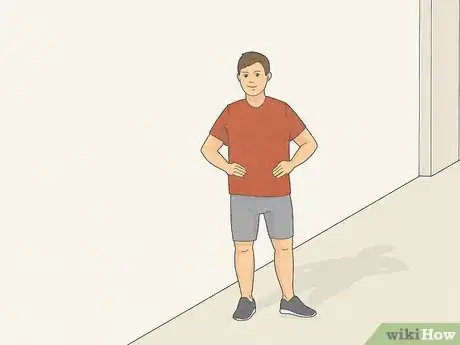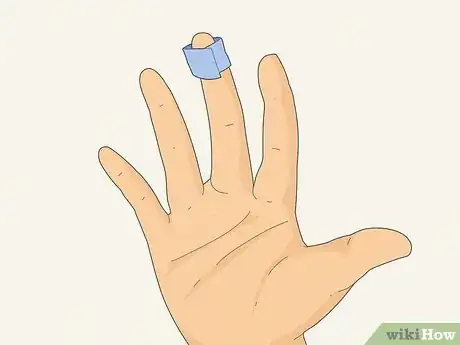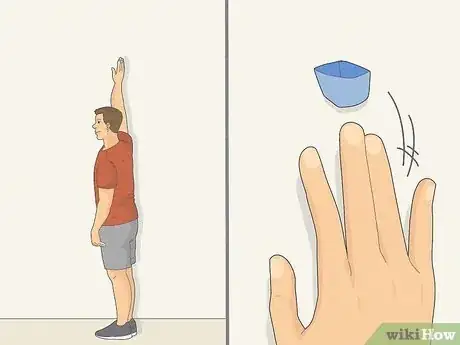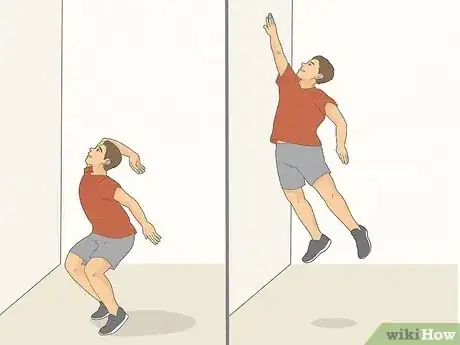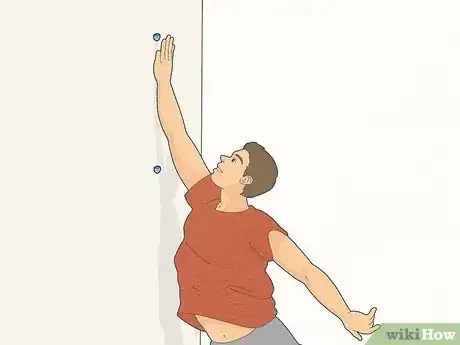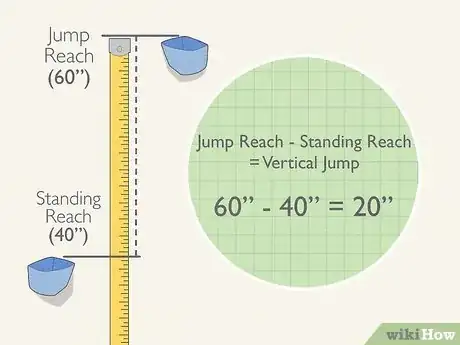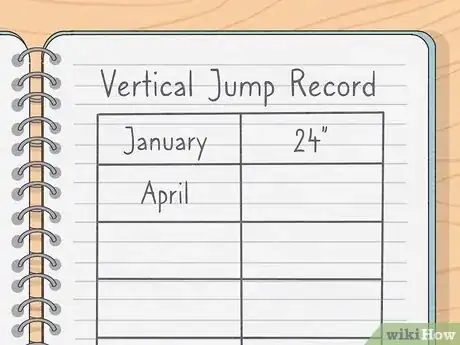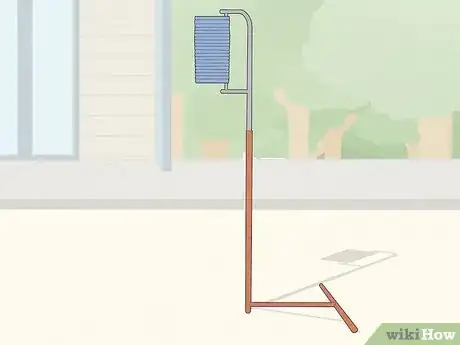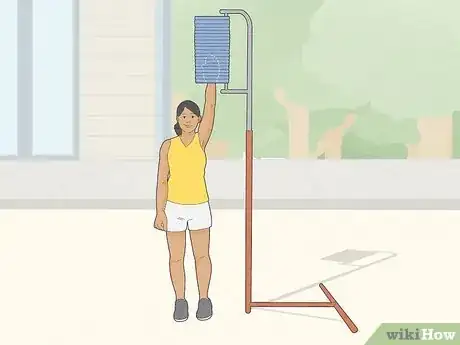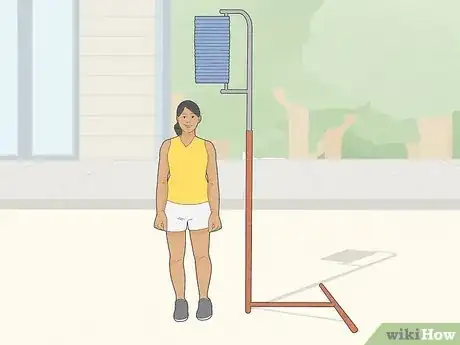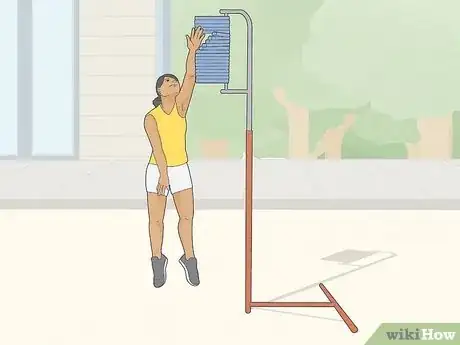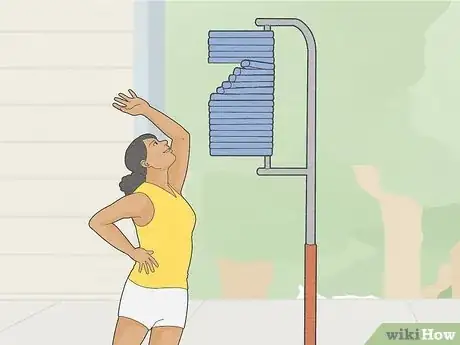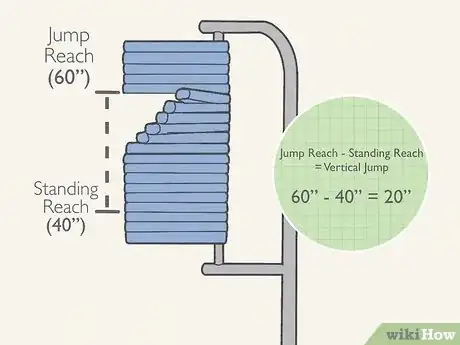This article was co-authored by wikiHow staff writer, Dan Hickey. Dan Hickey is a Writer and Humorist based in Chicago, Illinois. He has published pieces on a variety of online satire sites and has been a member of the wikiHow team since 2022. A former teaching artist at a community music school, Dan enjoys helping people learn new skills they never thought they could master. He graduated with a BM in Clarinet Performance from DePauw University in 2015 and an MM from DePaul University in 2017.
This article has been viewed 3,718 times.
Learn more...
A good vertical jump is a great asset in sports like basketball or volleyball, but what’s the best way to measure it? Measuring your vertical jump is simple—just subtract your standing reach from your jump reach. The result is your vertical jump measurement. You can do this yourself at home against a wall or with an easy-to-use piece of jump testing equipment called a Vertec. In this article, we’ll walk you through how to measure your vertical jump with and without equipment so you can accurately track your progress. If you’re ready to jump to it, keep scrolling!
Things You Should Know
- Stand against a wall and mark your standing reach and jump reach with chalk or tape. The difference between them is your vertical jump measurement.
- On a Vertec jump tester, record the heights of the vanes you tap during your standing and jump reach. The difference is your vertical jump.
- Record your measurements to track your progress and improve your vertical jump height.
Steps
Measuring without Equipment
-
1Stand sideways against a high wall you can put chalk or tape on. Make sure you stand on a level floor or surface away from any furniture or wall decor for a safe jump. Choose a wall in a room with a very high ceiling, at a gym, or on the outside of a building so you have plenty of space to reach and jump.[1]
- Stand with your dominant side against the wall for a more natural jump and reach.
-
2Wrap your middle finger tip on your dominant hand in tape or chalk dust. Use a small piece of masking tape or double-sided tape you can easily stick onto the wall, or a chalk color that contrasts with the wall color. Use your middle finger since it’s your longest finger and will give you the highest reach and jump measurement.[2]Advertisement
-
3Reach as high as you can and mark your reach height on the wall. Keep your feet flat on the ground and reach upward with your taped or chalked hand. At the peak of your reach, touch the wall with your middle finger and leave a mark with the chalk or tape, then measure its height with a tape measure. This is your standing reach.[3]
- Write down your maximum reach measurement before you move into your jumps.
-
4Reapply your chalk or tape and take your first standing vertical jump. Stand in the same spot and position as you did to record your reach. Raise your arms over your head and throw yourself down into a squatting position, then jump straight up as quickly as you can. Reach as high as possible and mark the wall again at the peak of your jump.[4]
- Remember to land safely on both feet to avoid injury.
- Try to position yourself so that your jump mark is directly above your reach mark.[5]
-
5Jump 3 to 5 more times with a 1 minute rest between each jump. Do multiple jumps in case you need a few tries to get used to the form or your first jump just wasn’t your best. Give yourself time to rest between jumps so your later jump measurements are affected by fatigue.[6]
- Remember to reapply tape or chalk to your finger and mark the wall each time you jump.
- Limit yourself to a handful of jumps. Otherwise, fatigue sets in and your measurements will continue getting lower.[7]
-
6Subtract your standing reach from your jump reach. Use a measuring tape to record your highest jump reach, then subtract your standing reach from before. The difference between these measurements is your vertical jump.[8]
- You now have 3 helpful measurements—your standing reach, your jump reach, and your vertical jump.
- If you only need your vertical jump and not your standing or jump reach, just measure the distance between your reach mark and best jump mark.
- Some people prefer to record the average of all their jumps instead of their best jump.[9]
-
7Record and track your progress to improve your vertical jump. Write down your best measurement in a tracking journal or spreadsheet so you can watch your progress over time and stay motivated.[10] Test yourself every 6 to 12 weeks to track improvement over long periods of time.[11]
- A jump of 20–24 inches (51–60 cm) for men or 16–20 inches (41–50 cm) for women is considered an above average vertical jump.[12]
- Anything over 28 inches (70 cm) for men or 24 inches (60 cm) for women is considered excellent.
Measuring with a Vertec Jump Tester
-
1Set up your Vertec on a flat surface where you have room to jump safely. Choose a room with high ceilings, a gym, or a spot outdoors. Use a pole or stick nearby to turn the vanes outward (away from the Vertec pole) and align them evenly. If you don’t have a pole, lower the measuring apparatus and adjust the vanes by hand.[13]
- The vanes are the plastic flags or pegs at the top of the Vertec. They’re spaced out in 0.5 in (1.3 cm) increments.
- Consider placing weights around the base of your Vertec to stabilize it during your jumps.
- Most Vertecs or similar measuring equipment extend up to 12 feet (3.7 m) tall.
-
2Record your standing reach on the Vertec. Stand to the side of the pole and keep your feet flat on the ground. Reach up as far as possible with your dominant hand and tap the highest vane you can reach with your middle finger tip. Measure the height from the ground to this vane and record your standing reach.[14]
- Afterward, use your pole to move the vanes underneath your standing reach toward the inside of the Vertec to get them out of the way.
- Alternatively, raise the height of the vanes so that the lowest one is just barely above your middle finger tip when you raise your arm.[15]
- If preferred, measure your standing reach against a wall and subtract this measurement from your jump reach later.
-
3Position yourself underneath the vanes for your first vertical jump. Stand almost directly under the vanes so that all your jumping power is directed upward. If you’re too far away and have to move forward, gravity will pull you down slightly before you reach the vanes.[16]
- This also ensures your reach goes straight up instead of having to reach forward slightly.
-
4Jump as high as you can and tap the highest vane you can reach. Raise your arms over your head and throw yourself down into a squat, then jump up as fast as you can. At your peak, tap the vane with your middle finger to move it and mark your jump.[17]
- Make sure not to take any steps or get a running start before your jump. This leads to inaccurate measurements.
- Land safely on both feet to prevent injury.
-
5Take 3-5 more jumps and record your highest jump reach. Between every jump, use your pole to turn the vanes you tapped toward the Vertec, then straighten out the remaining ones for your next jump. Continue jumping until you’re unable to reach any more of them. Measure and record the height of the topmost vane you hit (this is your jump reach).[18]
- Rest 1 minute between jumps to avoid fatigue.
-
6Subtract your standing reach from your jump reach. After measuring your highest jump, subtract your standing reach from earlier—the difference between these measurements is your vertical jump. If you raised the vanes to begin at your standing reach, count the number of vanes you moved. Each one represents 0.5 in (1.3 cm).[19]
- Divide the number of vanes by 2 to get your vertical jump in inches.
- Most Vertecs measure in inches, but there may be some that use centimeter increments.
-
7Record your result to track your progress and improve your jump. Jot down your maximum vertical jump (along with your standing and jump reach, if needed) in a fitness journal or spreadsheet.[20] Test yourself every 6 to 12 weeks to watch your progress over long periods of time.[21]
- Jumps ranging 20–24 inches (51–60 cm) for men or 16–20 inches (41–50 cm) for women are above average.[22]
- Jumps over 28 inches (70 cm) for men or 24 inches (60 cm) for women are considered excellent.
Warnings
- Don’t take any steps or get a running start before your jump if you’re measuring on a wall, since this could lead to injury.⧼thumbs_response⧽
References
- ↑ https://dunkorthree.com/how-to-measure-vertical-jump/
- ↑ https://dunkorthree.com/how-to-measure-vertical-jump/
- ↑ https://dunkorthree.com/how-to-measure-vertical-jump/
- ↑ https://jvavolleyball.org/3-methods-to-track-the-vertical-jump/
- ↑ https://dunkorthree.com/how-to-measure-vertical-jump/
- ↑ https://sportscienceinsider.com/vertical-jump-test/
- ↑ https://dunkorthree.com/how-to-measure-vertical-jump/
- ↑ https://jvavolleyball.org/3-methods-to-track-the-vertical-jump/
- ↑ https://sportscienceinsider.com/vertical-jump-test/
- ↑ https://dunkorthree.com/how-to-measure-vertical-jump/
- ↑ https://sportscienceinsider.com/vertical-jump-test/
- ↑ https://sportscienceinsider.com/vertical-jump-test/
- ↑ https://www.topendsports.com/testing/products/vertical-jump/vertec.htm
- ↑ https://sportscienceinsider.com/vertical-jump-test/
- ↑ https://www.topendsports.com/testing/products/vertical-jump/vertec.htm
- ↑ https://jvavolleyball.org/3-methods-to-track-the-vertical-jump/
- ↑ https://jvavolleyball.org/3-methods-to-track-the-vertical-jump/
- ↑ https://sportscienceinsider.com/vertical-jump-test/
- ↑ https://www.topendsports.com/testing/products/vertical-jump/vertec.htm
- ↑ https://dunkorthree.com/how-to-measure-vertical-jump/
- ↑ https://sportscienceinsider.com/vertical-jump-test/
- ↑ https://sportscienceinsider.com/vertical-jump-test/
- ↑ https://jvavolleyball.org/3-methods-to-track-the-vertical-jump/
- ↑ https://jvavolleyball.org/3-methods-to-track-the-vertical-jump/
- ↑ https://sportscienceinsider.com/vertical-jump-test/
